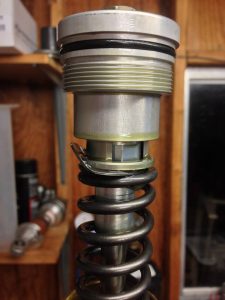The proper springs, the best valving, and a set of refreshed suspension is half the battle in having a proper handling bike. Troubleshooting can be a difficult task and somewhat confusing. Because of this tuning can be frustrating and easy to lose your way. Follow these 3 guidelines to help you troubleshoot and keep you on track.
SPRINGS ARE POSITIONAL
Not sure if you should adjust spring preload or compression? Keep in mind that springs  support weight and are based on position. What does that mean? Think of a long sweeper like a highway clover on-ramp. Once a turn is started the rider is leaned over for a long period of time. While leaned over, the suspension doesn’t move much and is supported by the springs. So if the front end bottoms or is at the bottom of the stroke in this instance, adding preload would remedy this problem.
support weight and are based on position. What does that mean? Think of a long sweeper like a highway clover on-ramp. Once a turn is started the rider is leaned over for a long period of time. While leaned over, the suspension doesn’t move much and is supported by the springs. So if the front end bottoms or is at the bottom of the stroke in this instance, adding preload would remedy this problem.
DAMPING REQUIRES VELOCITY
Rebound and Compression damping require velocity, or movement, to work. Oil needs to flow through the piston and the shims to create damping. So if there is no movement (like the example above) then addling compression will not be as affective compared to preload. Now if the forks bottom while braking, or the shock has excessive squat on acceleration, the adjustment I would go to would be compression. Make sense?
STICTION IS BAD

Stiction is the number one enemy of suspension. What is considered stiction you ask? ANYTHING that keeps the suspension from moving freely. Bent tubes/shafts, old seals, misalignements, rubbing against non-moving parts, etc. One can never completely remove stiction, but we can try and minimize the issue.
The picture to the left shows a bent washer rubbing again the inside of the fork tube. This created drag and kept the fork from being controlled by damping.
TUNING SUSPENSION IS DIFFICULT
Tuning and troubleshooting suspension can be a very difficult task. Getting off track and looking at the wrong setting can happen to even the best. The guidelines above are exactly that, guidelines. They won’t have all the answers, but they will help keep you on track when trying to troubleshoot an issue.

